- | 8:00 am
This smart new search site is like a mashup of Google and ChatGPT
A sleek tool called Andi combines the convenience of a chatbot with the credibility of a standard search setup—and it might just be the answer we need.

I’m not typically one for grandiose, over-the-top proclamations. But my goodness: It sure does seem like we’re approaching a pivotal moment in the evolution of search.
While most of us continue to rely on regular ol’ text interfaces for finding the info we need, a rapidly growing number of reports—including one from Google itself—indicates that young people are increasingly turning to TikTok instead of traditional search engines.
And at the same time, the ever-expanding attention around AI-driven chatbots like ChatGPT, is raising tricky questions about what the future of search should look like, and even whether it’s time to put the conventional list-driven results to rest.
While the hype around those systems may feel new, the sentiment driving their development is something Angela Hoover knows well. Hoover, 24, is a cofounder and the CEO of a Y Combinator-backed AI-powered search startup called Andi. And along with her cofounder Jed White—a veteran techie who’s been involved with search and AI for almost as long as Hoover has been alive—she’s been working to usher in a new era of search for a solid few years now.
Hoover and White met serendipitously during a layover in the Denver airport, and they quickly discovered a shared passion for pondering the possibilities that an AI-empowered search system could create. As luck would have it, that style of contemplation fit right in with White’s software-engineering background and his belief that a smarter search strategy was already in front of us and waiting to be given life.
“We’ve already predicted in science fiction what the next generation of search is going to look like, and to us, that’s like Jarvis, or Samantha from Her, or C-3PO from Star Wars,” Hoover says.
Futuristic as that description may sound, Andi actually sits somewhere between the traditional search sites, such as Google, and the completely conversational, chat-emulating challengers like ChatGPT. It aims to blend the best of both worlds into a new sort of search experience that’s both fresh-feeling and familiar. At a time when so many folks are asking questions about what search should even be, it’s an interesting balance that moves toward the future while still embracing the past.
THE ANDI SEARCH STRATEGY
When you first pull up the Andi website, you’re greeted by a friendly looking prompt to enter any question or query you want. Kind of like a chat session so far—right?
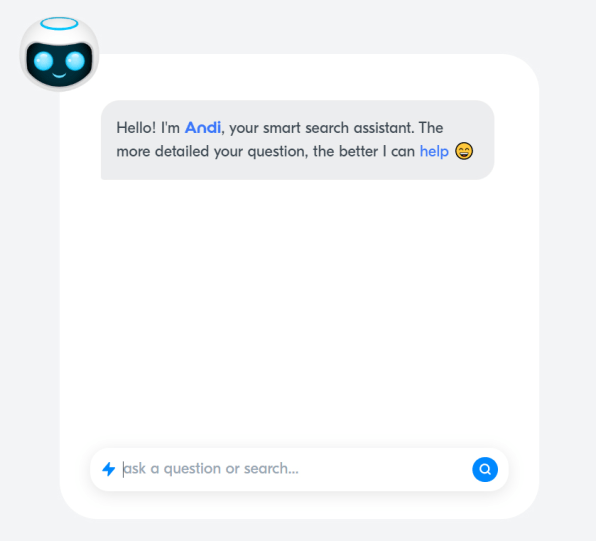
Where Andi takes a twist, though, is in what comes next, when the service combines that contemporary-chat approach with a more conventional-search interface. Yes, Andi always gives you a conversational answer to your question—even providing a clear citation of where the info came from, which is something ChatGPT notably does not do (and something Google’s sister company DeepMind is reportedly working to perfect prior to launching its own chatbot service).
But Andi also shows you a separate panel with a scrolling series of more standard web results—right alongside the chat window on desktop or accessible via a “Full search results” link on mobile—in case you want to dig deeper. You can even click over to news or image results to refine the search further, just like you might with Google or any other typical search website.

“It’s using the power of [AI interaction] but with factual grounding to make sure we’re giving you really high-quality and accurate-generated answers,” says Hoover.
This week, Andi is in the midst of rolling out an update that adds in even more AI capabilities beyond just search. The service can now perform tasks like summarizing a long article for you, writing an email on your behalf, or giving you ideas for a LinkedIn post on a specific subject—all through that same chat-like setup.
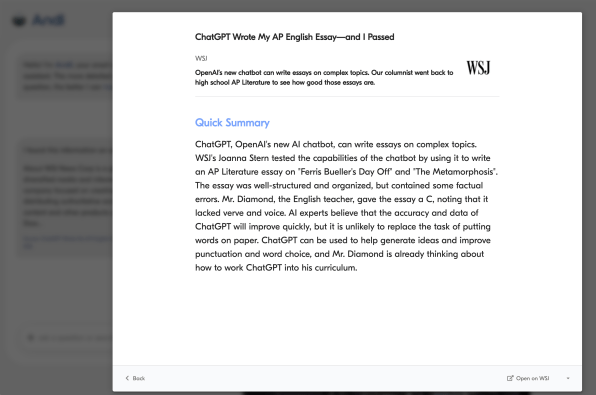
“My generation, Gen Z . . . is hungry for a new type of search engine,” says Hoover. “So we’re starting with search, but the thing we’re most excited about is how you [can] use AI to be a smart assistant that can actually perform tasks on your behalf, too.”
The ultimate goal is for Andi to become an all-in-one resource for anything you need, whether it’s basic information, a more complex form of content creation, or eventually even the types of tasks you might turn to a service like Google Assistant for handling—things like making reservations at a restaurant, for instance.
But even when it comes down to the simplest form of online searching, Andi sports some conspicuous differences over the current search standards.
A DECIDEDLY DIFFERENT SEARCH PHILOSOPHY
One thing you’ll notice right away when you use Andi is that searches aren’t always as instantaneous as you’ve grown accustomed to expecting. Whereas Google has long drawn attention to the precise number of milliseconds each search takes to complete, Andi takes an extra beat in order to provide a more up-to-the-minute, interactive-feeling experience.
And it isn’t just for show, either: Unlike Google, Andi deliberately doesn’t rely on an eternally updating roadmap of the entire internet to power its knowledge. Instead, it looks things up as you ask for them and then delivers the most current information on the spot, even down to the second.
“You don’t have to index the whole entire web because most of the best information can be pulled from live data on the fly,” Hoover says.
As part of that, Andi looks at what information a site like Google or Bing might show you. But it also directly polls a sprawling list of other sources to serve up what’s hopefully an even more timely list of relevant answers.
The result is a very different way to experience information. For one example, when I search Google for the question “Who is JR Raphael,” it gives me a simple list of web-based results—starting with my profile page at Computerworld, another site where I write, and then moving on to my own personal writing site and other such website sources.
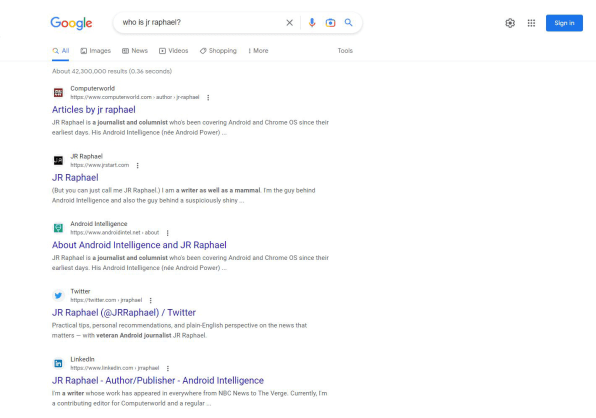
~
Andi, on the other hand, breaks out a specific paragraph of text pulled from one of my bios in its chat interface and then serves up a large link to that source page alongside it—with an infinitely scrolling stream of other results also there for the browsing.
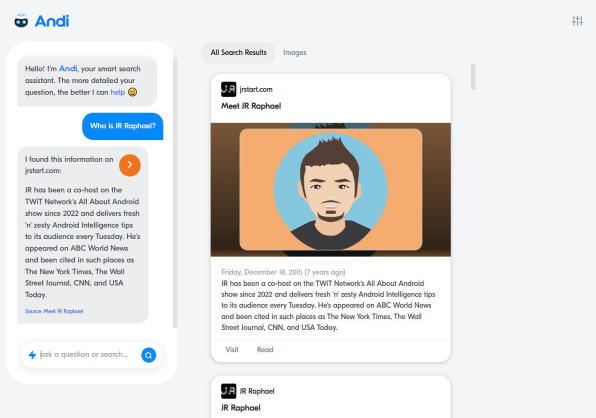
Neither approach is entirely perfect, in this specific scenario. Andi’s summary didn’t really capture the most important parts of my professional bio or give anywhere near a complete answer. But it certainly got a lot closer than Google’s link-list alternative.
All surface-level differences aside, Andi’s approach offers some interesting practical advantages over the current status quo. When you come across any sort of article in Andi’s results, for instance, you see a little “Read” option within its card. Tapping that gives you a stripped-down, nicely formatted, and completely ad-free view of the entire article right then and there—without ever having to leave Andi.
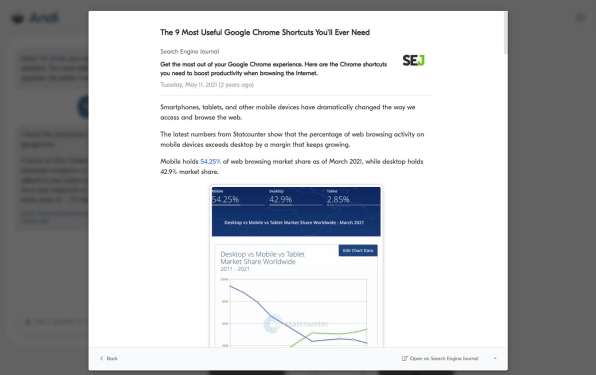
Publishers probably won’t rejoice at that notion—and it may well raise some thorny questions and challenges down the line—but it’s hard to deny it creates a pleasant experience from the perspective of the person doing the reading.
And speaking of ads, Andi doesn’t have ’em—at all. The service is built around a philosophy of zero ads and zero privacy compromises. Its privacy policy promises it doesn’t collect any form of personal data; doesn’t store any cookies, IP addresses, or locations; and doesn’t keep any records of incoming searches. The site even offers a simple text command, /clear, that you can type in anytime to clear your current session and all the history around it. And while the company plans to make money via paid premium and business plans in the future, it intends to keep its primary offering both free and free from any advertising or data collection.
No doubt, going up against Google and all the other power-players clamoring for a piece of the AI chatbot pie is a pretty daring gamble—particularly for a startup that currently claims its founders as its two sole full-time employees. But for the duo behind Andi, it’s par for the course and part of their deliberately ambitious mission to reshape the future of search.
“We’re super-excited to see competition and innovation happening in the space,” Hoover says. “That’ll just push us to become better.”
Be the first to know about all sorts of fascinating new productivity tools with my Android Intelligence newsletter—now completely free for you.








































